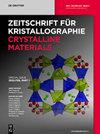2-和4-(甲硫基)苯甲酸的粉末X射线衍射、Hirschfeld表面分析和DFT研究
IF 2.7
4区 材料科学
Q3 CRYSTALLOGRAPHY
Zeitschrift Fur Kristallographie-Crystalline Materials
Pub Date : 2023-06-16
DOI:10.1515/zkri-2022-0069
引用次数: 0
摘要
摘要2-(甲基硫代)苯甲酸(1)是邻取代苯甲酸衍生物,而4-(甲基硫代)苯甲酸(2)是对取代苯甲酸衍生物。用PXRD数据对两种化合物进行了结构分析。2-(甲基硫代)苯甲酸呈三斜系,具有p1 - $P\overline{1}$空间群,而4-(甲基硫代)苯甲酸呈单斜系,在P21/a空间群中结晶。强度,以及分子间氢键的相对贡献,已经通过Hirshfeld表面和二维指纹图进行了检测。邻位取代的2-(甲基硫代)苯甲酸仅存在弱的分子内氢键。1的超分子框架是由分子内和分子间相互作用形成的,而2的分子间接触形成超分子组装。涉及羧基的分子间O - h⋯O相互作用形成了两种化合物的R22(8)图集基序。利用B3LYP相关泛函的理论DFT计算表明,相对于羧基,甲基硫基在邻位的化合物1的HOMO-LUMO轨道的能隙小于甲基硫基在对位的化合物2的能隙。还计算了两种化合物的垂直电离能和绝热电离能。本文章由计算机程序翻译,如有差异,请以英文原文为准。
Structure determination through powder X-ray diffraction, Hirshfeld surface analysis, and DFT studies of 2- and 4-(methylthio)benzoic acid
Abstract 2-(methylthio)benzoic acid (1) is an ortho-substituted benzoic acid derivative, whereas 4-(methylthio)benzoic acid (2) is a para-substituted benzoic acid derivative. The structural analysis of both compounds was carried out using PXRD data. 2-(methylthio)benzoic acid shows a triclinic system with the P 1 ‾ $P\overline{1}$ space group, whereas 4-(methylthio)benzoic acid shows a monoclinic system and crystallizes in the P21/a space group. The strength, as well as relative contributions of intermolecular hydrogen bonds, have been examined through Hirshfeld surfaces as well as 2D fingerprint plots. A weak intramolecular hydrogen bond was found only in the case of ortho-substituted 2-(methylthio)benzoic acid. Supramolecular frameworks for 1 are formed by the interplay of intramolecular and intermolecular interactions, whereas for 2, intermolecular contacts form supramolecular assemblies. Intermolecular O–H⋯O interactions involving carboxyl groups form the R22(8) graph-set motif for both compounds. Theoretical DFT calculations using the B3LYP correlation functional reveal that the energy gap of HOMO–LUMO orbitals in compound 1, with the methylthio moiety in the ortho position relative to the carboxyl group, is lower than that of compound 2, with the methylthio moiety in the para position. Vertical and adiabatic ionization energies are also calculated for both compounds.
求助全文
通过发布文献求助,成功后即可免费获取论文全文。
去求助
来源期刊

Zeitschrift Fur Kristallographie-Crystalline Materials
CRYSTALLOGRAPHY-
CiteScore
2.00
自引率
16.70%
发文量
55
期刊介绍:
Zeitschrift für Kristallographie – Crystalline Materials was founded in 1877 by Paul von Groth and is today one of the world’s oldest scientific journals. It offers a place for researchers to present results of their theoretical experimental crystallographic studies. The journal presents significant results on structures and on properties of organic/inorganic substances with crystalline character, periodically ordered, modulated or quasicrystalline on static and dynamic phenomena applying the various methods of diffraction, spectroscopy and microscopy.
 求助内容:
求助内容: 应助结果提醒方式:
应助结果提醒方式:


